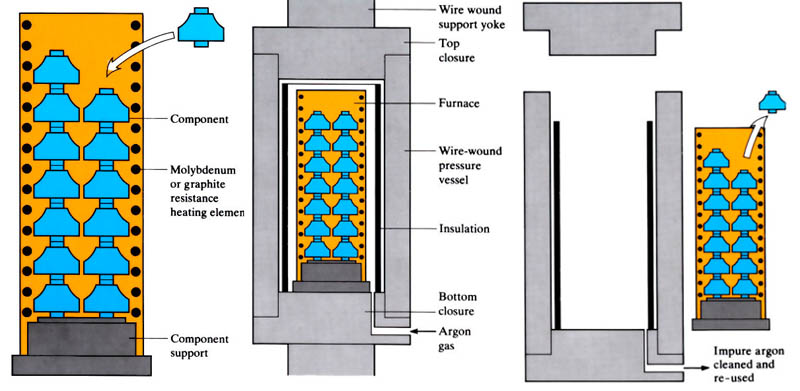Isostatic pressing is process in which the overall density of a component is increased by removing excess liquids and voids. This usually happens during a two-part process to ensure that the material is structurally strong and withstands massive amounts of force when under stress. The component, usually a powder, is first subjected to extreme temperatures to remove moisture, and a high vacuum is also applied to remove any impurities it may contain. While this is happening, inert gases are introduced into the enclosed environment until internal pressure creates a uniform metallurgical bond within the grain-sized particles.

Application of Hot Isostatic Pressing
1. Densification of castings
At present, hot isostatic pressing technology is not only used in casting processing, powder metallurgy, ceramic industry, but also in porous materials, near net shape, material bonding, plasma spraying, manufacturing high-end graphite and other fields.
2. Application in powder metallurgy
In order to obtain a uniform and fine structure, reduce material loss, reduce subsequent machining, etc., more and more powder metallurgy products are molded and densified by hot isostatic pressing process. Such as powder metallurgy high-speed steel; stainless steel, such as AISI-304 stainless steel; powder metallurgy superalloys, such as aircraft engine turbine discs; various radiographic targets; powder metallurgy parts for automobiles; Chemical pumps, valves and multi-channel distribution pipes, etc.
3. Application in ceramic materials
HIP technology is used in the production of ceramic materials, improves the molding and sintering conditions, significantly reduces the porosity of the material, thereby improving the performance of the material, and provides an effective method for the manufacture of ceramic materials, these methods mainly include: high-temperature impregnation of porous ceramics, diffusion bonding, sintering + HIP pressing, HIP consolidated powder and HIP forging.
4. HIP cladding and HIP composite diffusion connection
HIP cladding and HIP composite diffusion bonding is another important application of HIP pressing. HIP cladding technology is a new technology that uses HIP technology to prepare a cladding with special physical or chemical properties on a material to improve its comprehensive properties; HIP composite diffusion connection is a new technology that diffusion connection of 2 or more different materials under the action of high temperature and high pressure, and the materials involved can be metal-metal, metal-non-metal, non-metal-non-metal, it is a good technology developed in recent years, especially in civil use.
5. Other new fields
In addition to the main application areas mentioned above, HIP technology also includes the following applications:
(1) In the application of porous materials, due to the use of nitrogen as a medium, nitride is generated at high temperature, so that HIP also has an effect on porous materials;
(2) HIP technology is combined with surface treatment such as nitriding to expand the HIP function;
(3) HIP technology can be used to prepare high-purity materials in the suspension smelting process, because the density of high-pressure gas increases, the melt can be suspended and crucible-free melting can be realized, thereby greatly improving the purity of smelting;
(4) The food industry adopts HIP technology, which can make the food achieve the purpose of sterilization and disinfection without destroying the nutrition and maintaining the original color and flavor, which provides a new way for food processing;
(5) Material bonding. Material bonding is the most original application of HIP technology and has been recognized by the United States Welding Society. Under the condition of HIP process, two or more materials of the same or dissimilar materials can be firmly bonded together to form a whole. The advantages of the bonding process are that the processing cost is low, the bonding temperature is low, and the performance of the bonding zone is similar to that of the matrix;
(6) To manufacture high-end graphite products, it combines molding and roasting into one, simplifies the process steps, saves production costs, and reduces the number of roasting and impregnation.



 13509827936
13509827936
 E-mail
E-mail
